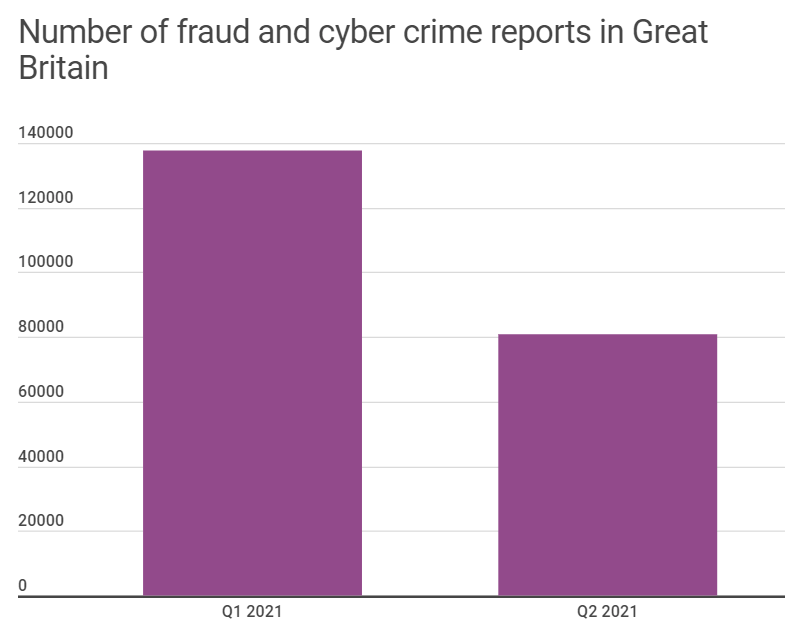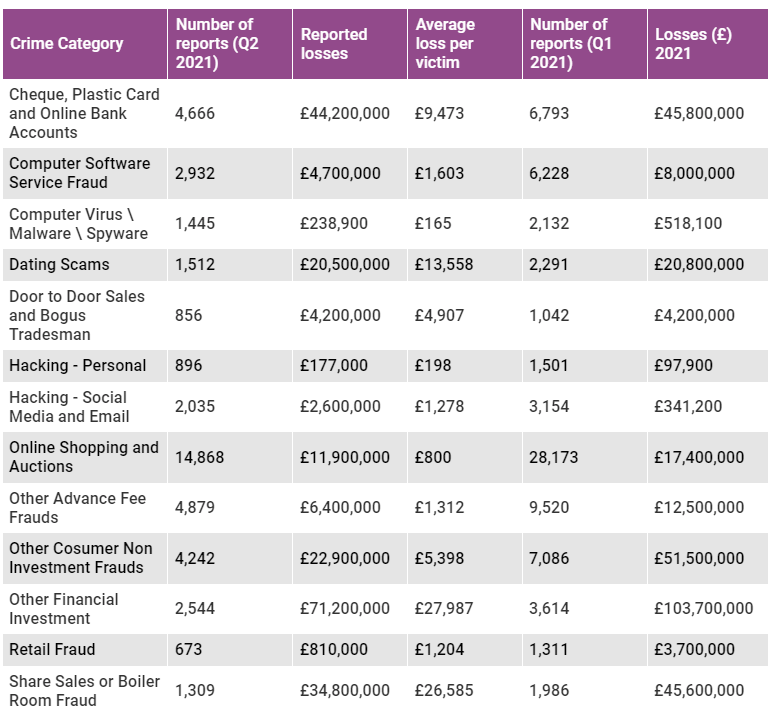Contents:
According to money.co.uk’s latest Quarterly Fraud and Cyber Crime Report, UK residents have lost over £1 billion to fraud and cybercrime in the first six months of 2021.
The analysis conducted by senior editor James Andrews revealed that in the second quarter of 2021, there were 81,018 cases of fraud and cybercrime, resulting in a reported £382.3 million lost to criminals. In comparison, there were 137,695 crimes between January-March 2021 at a cost of £625.6 million.
It seems that this decline is due to the easing of COVID-19 lockdown restrictions in Q2, as this reduced online activities.

Image Source: Quarterly Fraud and Cyber Crime Report
According to the report, the most common type of fraud and cybercrime in Q2 was related to online shopping and auctions, comprising one in five police reports (14,868). Victims of online shopping and auction scams lost £11.9m to this type of fraud.
As reported by Infosecurity, the number of reports fell by half compared to Q1, which could be due to the reopening of non-essential retail in Q2, thereby reducing the volume of e-commerce transactions. Average losses per victim were 29% higher in Q2 than Q1 (£800 vs. £618).
Crimes relating to financial investments, share sales, or boiler room fraud proved to be most costly to victims in Q2. No less than 1309 victims lost £35.8m to these activities in this period, equating to £26,585 per person.
Dating scam victims also experienced heavy losses, with 1,512 reports in Q2 and a £13,558 average loss per victim.

Image Source: Quarterly Fraud and Cyber Crime Report
UK residents aged 70 and above were more likely to fall victim to fraud and cybercrime than any other age category. In Q2 alone, this population lost £34.2m to these crimes, with an average of £6,118 lost per victim.
At the end of his analysis, James Andrews said:
Brits have lost more than a billion pounds as a result of fraudulent and cybercrimes, showing the extent fraudsters have taken advantage of online shoppers during the national lockdown.
But it’s encouraging to see that cases have decreased significantly in the second quarter of the year, as life started heading back towards normality. Still, with millions of pounds lost, it’s vital that individuals are aware of what they should be doing to protect themselves against fraudsters.
Basic Security and Privacy Rules
- Check your privacy and security settings for every network and adjust them to fit your needs (sites allow you to choose how much personal information you want to make publicly accessible or keep private).
- Protect your personal information. Be careful of what you share online, you never know how that information can be used against you.
- Never download attachments that you never requested. Never click on short, hidden links, that you don’t know where they lead.
- Be aware of links that send you somewhere where you need to log in again or give up your credentials. Look at the domain – is it correct or it just looks similar to the right one, but uses a variation in spelling? Are you on a secure website connection? Does the link start with “HTTP” instead of “HTTPS”?
- Be aware of any kind of misspellings, extra punctuation, amateurish design (including stock photos or low-resolution images). These may all be signs of fraud or fake social profiles.
- If a brand’s social profile seems suspicious, look if there’s any mention of the official website. Pay attention to it, make sure they don’t mention a similar website, but with a slight variation in spelling or domain. You can also look out for blue checkmarks – these are used by social networks to mark verified brands.
- Check all apps that you previously authorized or are linked to your account (third-party apps). Remove any shady app, especially ones that don’t do what they claimed to, or ones that you don’t use anymore. Do not install or give credentials to third-party apps that you don’t know or don’t trust.
- Constantly change your passwords. Choose strong passwords, that are hard to break: they should be at least 14 characters long, and make sure you mix lower with upper cases, symbols, digits. Never recycle them – they should be unique.
- Start using two-factor authentication everywhere you can: email account, social networks, banking.
- Report and then delete any kind of spam or malicious messages that you run into.


 Network Security
Network Security
 Vulnerability Management
Vulnerability Management
 Privileged Access Management
Privileged Access Management
 Endpoint Security
Endpoint Security
 Threat Hunting
Threat Hunting
 Unified Endpoint Management
Unified Endpoint Management
 Email & Collaboration Security
Email & Collaboration Security










